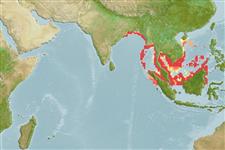>
Clupeiformes (Herrings) >
Dorosomatidae (Gizzard shads and sardinellas)
Etymology: Anodontostoma: Greek, ana = up + Greek, odous = teeth + Greek, stoma = mouth (Ref. 45335).
Environment: milieu / climate zone / depth range / distribution range
Ecologia
marino; salmastro; anadromo (Ref. 51243); distribuzione batimetrica 0 - 50 m (Ref. 188). Tropical; 24°N - 0°N, 85°E - 119°E (Ref. 188)
Indo-Pacific: Indian Ocean (northern part of Bay of Bengal, Andaman Sea at Phuket in Thailand), Gulf of Thailand, South China Sea. Also found in Indonesia (Ref. 7050). In earlier works, Anodontostoma chacunda was often misapplied to Anodontostoma thailandiae.
Size / Peso / Age
Maturity: Lm ? range ? - ? cm
Max length : 18.0 cm SL maschio/sesso non determinato; (Ref. 188); common length : 12.0 cm SL maschio/sesso non determinato; (Ref. 188)
Spine dorsali (totale): 0; Spine anali 0; Raggi anali molli: 17 - 25. Body depth increasing with size. Second supra-maxilla paddle-shaped. Lower gill rakers 46 to 140; longest gill rakers on lower part of arch equal to or longer than corresponding gill filaments. Last dorsal fin ray not filamentous. Hind edges of scales toothed, the teeth wider than gaps between them; a median series pre-dorsal scales. A large dark mark behind gill opening.
Occurs inshore and probably entering estuaries. Its biology is probably similar to A. chacunda.
Life cycle and mating behavior
Maturità | Riproduzione | Deposizione | Uova | Fecundity | Larve
Whitehead, P.J.P., 1985. FAO Species Catalogue. Vol. 7. Clupeoid fishes of the world (suborder Clupeoidei). An annotated and illustrated catalogue of the herrings, sardines, pilchards, sprats, shads, anchovies and wolf-herrings. FAO Fish. Synop. 125(7/1):1-303. Rome: FAO. (Ref. 188)
IUCN Red List Status (Ref. 130435)
Threat to humans
Harmless
Human uses
Pesca: pesca di sussistenza
Informazioni ulteriori
Nomi ComuniSinonimiMetabolismoPredatoriEcotossicologiaRiproduzioneMaturitàDeposizioneSpawning aggregationFecundityUovaEgg development
BibliografiaAcquacolturaProfilo di acquacolturaVarietàGeneticaElectrophoresesEreditarietàMalattieElaborazioneNutrientsMass conversion
CollaboratoriImmaginiStamps, Coins Misc.SuoniCiguateraVelocitàModalità di nuotoArea branchialeOtolithsCervelliVista
Strumenti
Special reports
Download XML
Fonti Internet
Estimates based on models
Preferred temperature (Ref.
123201): 27.6 - 29.3, mean 28.8 °C (based on 370 cells).
Phylogenetic diversity index (Ref.
82804): PD
50 = 0.6250 [Uniqueness, from 0.5 = low to 2.0 = high].
Bayesian length-weight: a=0.00912 (0.00433 - 0.01920), b=3.04 (2.87 - 3.21), in cm total length, based on LWR estimates for this (Sub)family-body shape (Ref.
93245).
Trophic level (Ref.
69278): 3.1 ±0.3 se; based on size and trophs of closest relatives
Resilienza (Ref.
120179): Alto, tempo minimo di raddoppiamento della popolazione meno di 15 mesi (Preliminary K or Fecundity.).
Fishing Vulnerability (Ref.
59153): Low vulnerability (12 of 100).
